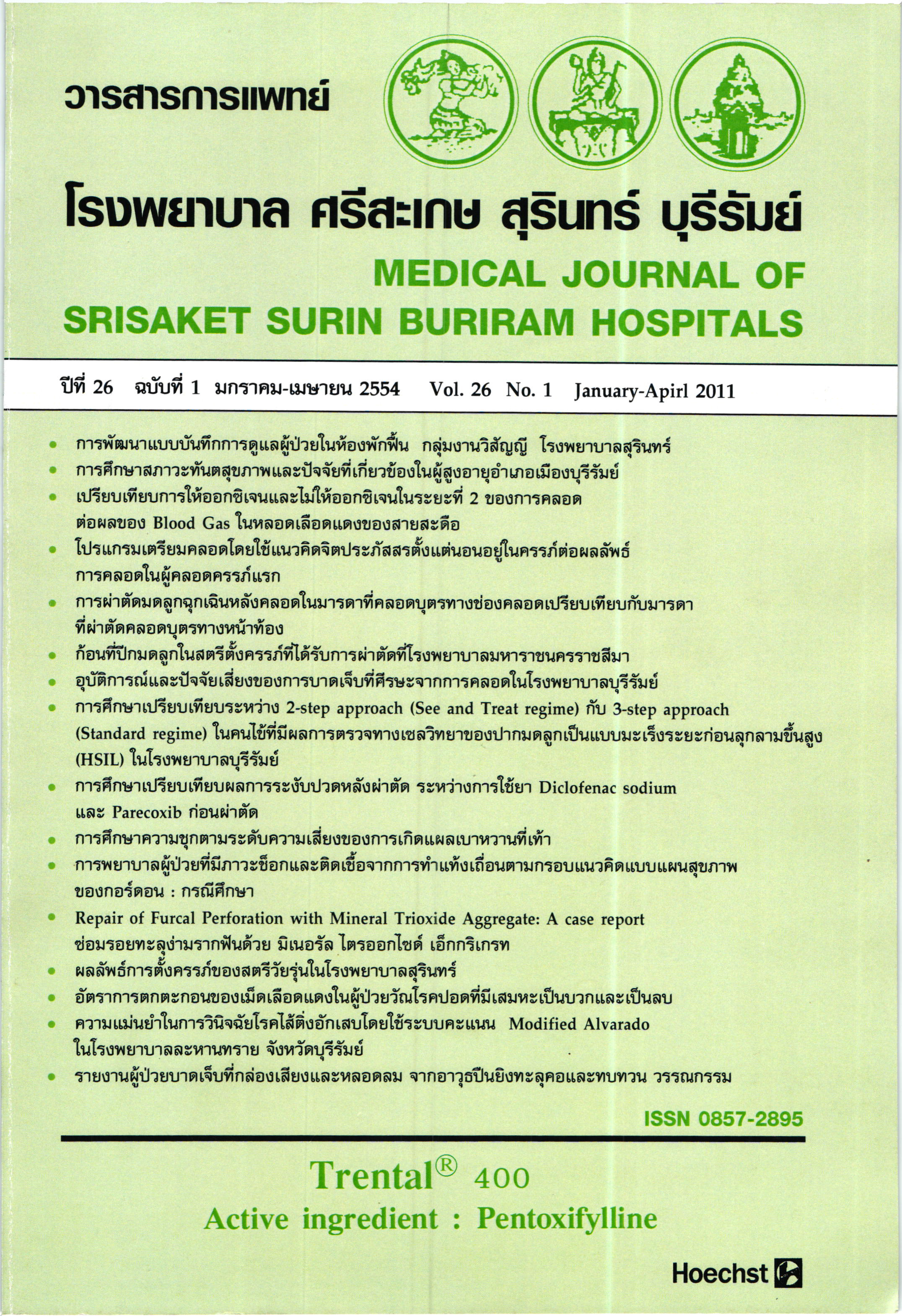อุบัติการณ์และปัจจัยเสี่ยงของการบาดเจ็บที่ศีรษะจากการคลอดในโรงพยาบาลบุรีรัมย์
Main Article Content
บทคัดย่อ
เหตุผลของการวิจัย: การบาดเจ็บจากการคลอด (birth trauma) เป็นภาวะแทรกซ้อนที่พบทางสูติกรรม การบาดเจ็บที่ศีรษะหรือศีรษะน่วมจากการคลอด เป็นภาวะที่ทำให้ทารกเกิดความพิการและเสียชีวิตได้
วัตถุประสงค์: การวิจัยนี้มีวัตถุประสงค์เพื่อศึกษาอุบัติการณ์และปัจจัยเสี่ยงที่ทำให้เกิดการบาดเจ็บที่ศีรษะจากการคลอด (cephal hematoma และ subgaleal hematoma) ของหญิงตั้งครรภ์ที่มาคลอดที่โรงพยาบาลบุรีรัมย์
สถานที่ทำการศึกษา: ห้องคลอดและห้องทารกแรกเกิด โรงพยาบาลบุรีรัมย์
รูปแบบการวิจัย: เป็นการศึกษาแบบกลุ่มเปรียบเทียบ
วิธีการศึกษา: หญิงตั้งครรภ์ที่มารับบริการคลอดที่ห้องคลอด โรงพยาบาลบุรีรัมย์ ตั้งแต่ 1 ตุลาคม 2552 ถึง 30 กันยายน 2553 พบทารกมีการบาดเจ็บที่ศีรษะจำนวน 70 ราย และ กลุ่มเปรียบเทียบจำนวน 140 ราย ได้แก่รายที่คลอดในเวลาถัดมาในอัตราส่วน 1:2 โดยตัดการคลอดก่อนกำหนด ครรภ์แฝด ทารกตายคลอดและทารกพิการรุนแรง ออกจากการศึกษา การวิเคราะห์ข้อมูลใช้โปรแกรมสำเร็จรูป SPSS, Chisquare, Fisher Exact test, multiple logistic regression และ student t test
ผลการศึกษา: ในทารกที่ได้รับบาดเจ็บที่ศีรษะจากการคลอด 70 ราย พบ cephal hematoma 42 ราย subgaleal hematoma 28 ราย เป็นจากการคลอดจาก vacuum จำนวน 45 ราย (ร้อยละ 64.3) พบอุบัติการณ์ 10.7 ต่อทารกเกิดมีชีพ 1000 ราย การตั้งครรภ์แรก การคลอด vacuum ทารกตัวโต และการคลอดโดยแพทย์ใช้ทุนเป็นปัจจัยเสี่ยงต่อการเกิดการบาดเจ็บทีศีรษะ การคลอด vacuum ก่อให้เกิดผลกระทบ ต่อทารกมากที่สุดทั้งในแง่ morbidities (ซีด ได้รับเลือด ตัวเหลือง และได้รับออกซิเจน) และเสียชีวิต 2 ราย
โดยมีภาวะการแข็งตัวของเลือดผิดปกติร่วมด้วย
สรุป: ปัจจัยเสี่ยงต่อการบาดเจ็บที่ศีรษะส่วนใหญ่เป็นจากการคลอดที่มีปัญหาและคลอดยาก การสังเกตทารกตัวโต การเลือกวิธีคลอดและเทคนิคการคลอดที่เหมาะสม จะช่วยลดอุบัติการณ์การบาดเจ็บที่ศีรษะจากการคลอดและภาวะแทรกซ้อนต่อทารกได้
Article Details
เอกสารอ้างอิง
Nasseri F, Badiei Z. Neonatal Subgaleal Hemorrhage“A Fetal complication of vacuum extraction delivery”. Iran J Ped 2007; 17(3): 297-301.
Chadwick LM, Pemberton PJ, Kurinczuk JJ. Neonatal subgaleal hamatoma : associated risk factors, complications and outcome. J Paediatr Child Health 1996; 32(3) : 228-32.
Pollack S, Kassis I, Soudack M, Sprecher H, Gulburd JN, Makhoul TR. Infected subgaleal Hematoma in a neonate. The Pediatric infection Disease Journal 2007; 26(8) :757-9.
Strauss T, Kenet G, Schushan-Eisen I, Mazkereth R, Kuint J. Resuce Recombinant Activated Factor VII for Neonatal Subgaleal Hemorrhage. IMAJ 2009 ;11:639-40.
Clark SL, Vines VL, Belfort MA. Fetal injury associated with routine vacuum use during cesarean delivery. Am J Obstet Gynecol 2008;198(4):e4.
ภาสกร ศรีทิพย์สุโขม, พรรณพัชร พิริยะนนท์, สุธิดา ศรีทิพย์สุโขม อติวุทธ กมุทมาศ. การ บาดเจ็บจากการคลอดของทารกแรกเกิดในโรงพยาบาลธรรมศาสตร์เฉลิมพระเกียติ. วารสารวิชาการสาธารณสุข 2550;16(6):899-904.
Larola N. Birth Trauma. Medscape Reference(serial online) 2010 Mar 16 (cited 2011 Jan 12) ; 1-8 Aviable From: URL: https://emedicine,medscape.com/article/980112.
Cunningham FG, MacDonald PC, Gant NF, Leveno KJ, Gilstrap III LC, Hankins GD, Clark SL. Williams Obstetrics. 20th ed. Connecticut : Appleton & Lange 1997:998-99.
Gebremariam A. Subgaleal haemorrhage : risk factors and neurological and developmental outcome in surviors. Ann Trop Paediatr 1999;19:45-50.
Boo NY, Foong KW, Mahdy ZA, Yong SC, Jaafar R. Risk factors associated with subaponeurotic haemorrhage in fullterm infants exposed to vacumm extraction. BJOG 2005;112:1516-21.
Borna H, Borna S, Mohseni SM, Akhavi Rad Sied MB. Incidence of and Risk Factors for Birth Trauma in Iran. Taiwan J Obstet Gynecol 2010 ;49(2):170-73.
Gardella C,Taylor M,Benedetti T, Hitti J, Critchlow C. The effect of seguential use of vacuum and forceps for assisted vaginal delivery on neonatal and maternal outcomes. Am J Obstet Gynecol 2001;185(4):896-901.
Hughes CA, Harley EH, Milmoe G, Bala R, Martorella A. Birth trauma in head and neck. Arch Otolarynngal Head Neck Surg 1999;125:193-9.
Levine MG, Holroyde J,Woods JR, Siddiqi TA, Scott M, Miodovnik M. Birth Trauma: Incidence and Predisposing Factors. Obstetrics & Gynecology 1984;63(6):792-5.
Uchil D, Arulkumaran S. Neonatal Subgaleal Hemorrhage and Its Relationship to Delivery by Vacuum Extraction. Obstetrical and Gynecological Survey 2003;85(10)687-93.
Florentino-Pineda I, Ezhuthacham SG, Sineni LG,Kumar SP. Subgaleal hemorrhage in the newborn infants associated with silicone elastomer vacuum extractor. J Perinato 1994;14:95-100.
Kuit JA, Eppinga HG, Wallenburg HC, etal-A randomized comparison of vacuum extracton delivery with a rigid and a pliable cup.Obstst Gynecol 1993;82:280-4.
Cunningham FG, Gant NF, Leveno KJ, Gilstep LC, Hauth JC, Webstrom KD. Williams Obstetrics 21st ed. Conecticut: Appleton & Lange ; 2002:430-3.
Hyatt HW, Hyperbilirubinemia in a Newborn Infant Probably Related to Cephalhematama. Journal of the national Medical association 1964;56(4):329-30.
Dahl KM, Barry J, DeBiasi RL. Escherichia hermannii Infection of a Cephalohema- toma: Case Report, Review of the Literature, and Description of a Novel Invasive Pathogen. CID 2002;35(1)e96-8.
Davis DJ. Neonatal subgaleahemorrhage diagnosis and management. CMAJ 2001;64(10):1452-3.
Scott R, Roth S. images in neonatal medicine. Arch Dis Child Fetal Neonatal Ed 2006 ; 91 : F2002-3.
King SJ. Pictorial review Cranial trauma following birth in the term infants. The British Journal of Radiology 1998;71: 233-8.
Yarrow C, Benoit AG, Klein MC. Outcomes after vacuum-assisted deliveries Births attended by community family practitioners.Canadian Family Physician 2004; 50:1109-14.


